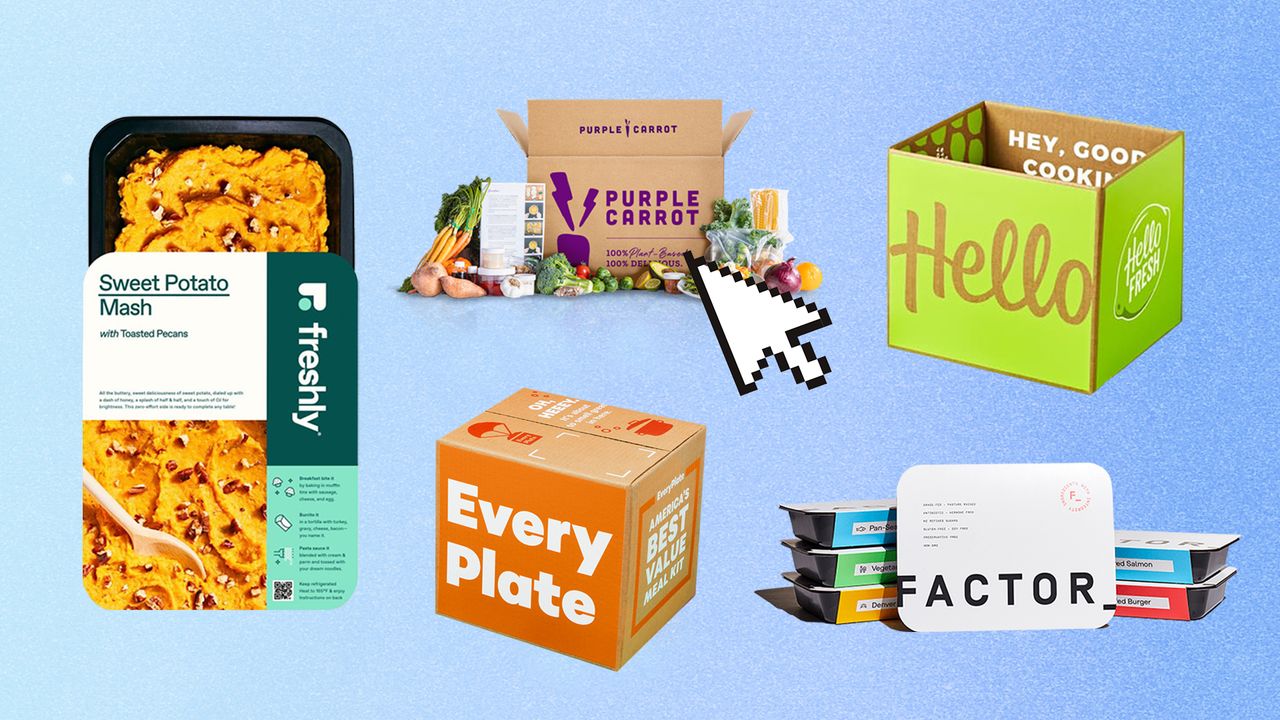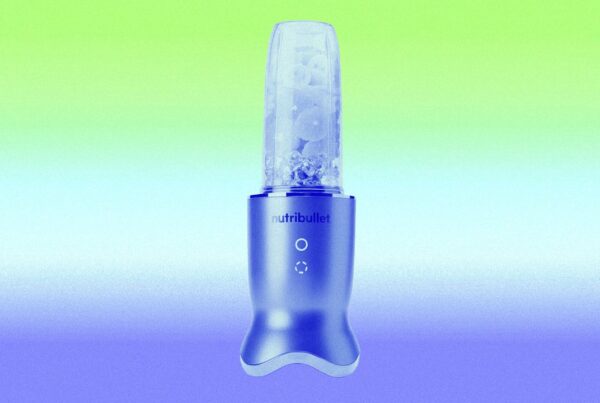The place I think Dinnerly truly shines is in its marketplace, which sits somewhere between a meal kit and a grocery delivery in the best way. It has a wealth of selections that suit the “busy professional on a budget” that I am: The Mediterranean Falafel Wrap was a cheap, flavorful, and filling lunch I could just pop in the oven and eat. The Bacon and Egg Breakfast Sandwich “Meal Shortcut” was just a package of Lopaus waffles, sous vide egg bites, and a tiny pack of bacon, but with the smallest effort, I had a couple of pretty tasty breakfast sandwiches. And the pre-packaged apple kouign-amann from KRMA Foods was flaky and satisfying with my afternoon coffee.
What’s the ordering process like?
It was pretty easy to get started with Dinnerly. Like most other meal kit services I’ve tried, they pre-pack your box with a trio of meals that you can go in and edit. Unlike those services, however, the options to choose from when editing my box were immense to say the least. There were endless recipes, geared toward kids, vegetarians, the calorie-conscious, allergy sensitive—so many that I gave up ever reaching the bottom and just made my picks. Luckily, everything from cost-per-serving to whether it’s a kid-friendly recipe is labeled.
That being said, in the 3 weeks I used Dinnerly, I had more delivery issues than I had expected. My second week (which happened to be around Thanksgiving), I received an email saying that due to distributor issues, my box was delayed without any indication for how long. When the box finally shipped the day after its original delivery day (Friday), they told me to expect it on Monday—and then the box surprised me by showing up on Saturday. My third week was actually an accident: I ended up committing to an extra week of this service during testing purely because there was little to no communication about the deadline to skip/edit my next box, a date that was different than the week before.
How was the unboxing experience?
As I had hoped, the boxes were well insulated and packaged fairly well, although I do miss the days when recipe ingredients were grouped together in little boxes or baggies. Dinnerly packs pretty much all produce, spice and sauce packets, and dry ingredients loosely together on the top layer, with all proteins below, close to the ice pack. While most ingredients traveled well, I did have a bag of peas get squished and spill open in the box, likely from rough handling. I appreciated how, apart from the ingredients, the package was simply the box, the cardboard-based insulation, and the ice pack, all of which are recyclable.
The best plant-based meal kit: Purple Carrot
Tester: Carina Finn, commerce editor
Favorite meal they tested: Crunchadillas Supreme
Click here for our full Purple Carrot review
Purple Carrot is one of the most user-friendly meal kits I’ve tried. The process is incredibly simple: just pick how many meals you want per week, click on a few appealing recipe photos, and have everything you need to recreate them delivered to your house a few days later. The meals are 100% vegan, and while my household is solidly omnivorous, we do make an effort to eat more plant-based foods. I never missed the meat in a Purple Carrot meal. I even found myself getting legitimately excited about my “healthy dinner at home” nights—especially since I didn’t have to grocery shop. All of the meal kits I tried took 30 minutes or less to put together, and they kept me from ordering takeout on more than one occasion. Purple Carrot offers a lot of variety: I could have West African Peanut Stew one night and their (extremely delicious) Crunchadillas Supreme the next. In fact, that riff on a crunchwrap supreme was so good, I ate it three days in a row. I’m not normally a mushrooms-as-meat-replacement person, but the Fable mushrooms in this kit were unreal in terms of both flavor and texture. This meal fell solidly into the deeply satisfying category of “healthy junk food.”
By and large, I found all of the meals to be really well-seasoned, which was a nice change from some other meal kits. Every once in a while I’d zhuzh things up with condiments, but for the most part I was happy to eat them as-is. There were some weeks where I wasn’t particularly excited about many of the options, but I was always able to find something I wanted, and it was often better than I expected.
What’s the ordering process like?
The ordering experience is super simple: you pick how many meals you want, and then you can scroll through pictures to decide what to add to your order. There’s always a pre-loaded selection, so if you forget to make choices, you’ll still get something. I liked that there were enough options to provide variety, but not so many that I got trapped in a scroll of indecision.
How was the unboxing experience?
Each kit is packaged in its own plastic bag with a recipe card. Ingredients are portioned exactly for the recipe, so you don’t end up with random leftovers. There is a lot of packaging, which I didn’t love, but it did help keep things organized within my box—and my fridge.
Looking for more vegetarian meal kits? Right this way
The Best Meal Kit for Sustainability: Green Chef
Tester: Kelsey Jane Youngman, senior service editor
Favorite meal they tested: Italian Turkey Stuffed Squash Boats with bulgur, kale, creamy parsley-basil pepita pesto
Green Chef is owned by another popular meal kit company, Hello Fresh, but offers (mostly) organic, seasonal produce, with an emphasis on lean (sustainably-sourced) protein, whole grains, whole fruits and vegetables, healthy fats, and low to no-added sugars. It’s the kit to try if buying organic is important to you, and/or if you want to incorporate recipes that meet the criteria for certain diets (keto, Mediterranean, high protein, etc.). They ship all of their sauces, stocks, and herb blends pre-mixed, and some of their veggies precut, to cut down on prep time. They also offer “Quick & Easy Lunches” with precooked proteins, and sell add-ons to their meals, like meat and seafood sampler packs, ready-to-blend smoothie kits, frozen desserts, canned coffees, protein shakes, additional side dishes, packaged ramen, and dumplings. They even emailed me an offer to include fresh dog food in my order (in partnership with The Pets Table).
The meals were very easy to cook: simply grab the labeled bag of the meal you’d like to make and the included full-color recipe sheet (printed on a nice, durable cardstock paper) and go. The recipe instructions were well-written and easy to follow, and included color pictures of every major step. They’re very clear about what they don’t include: salt, pepper, sugar, butter, and oil. Everything else you need is in the box. I am confident that a beginner cook could easily follow the instructions and make a delicious meal, but the cook times might vary based on experience and confidence in the kitchen. Most of the meals used at least 2 pans (a sheet pan and a skillet, for example) and prioritized smart, simultaneous cooking techniques (e.g. boiling the bulgur while the squash was roasting in the oven so you can focus on the pork filet on the stovetop). These are not (for the most part) one pan meals.
The food was, in general, good. I had favorites and a few misses, but nothing was truly terrible. My favorite meal (Italian Turkey Stuffed Squash Boats) consisted of well-seasoned ground turkey, bulked up with nutty bulgur and tender kale before getting spooned over golden brown roasted zucchini and topped with a creamy riff on pesto. The “boats” description is a bit funny because one zucchini was tiny and one was huge, so the filling overwhelmed the vessel, but the taste was great and presentation just didn’t matter that much to me in the end.
What I didn’t like mostly came down to personal preferences, rather than flawed recipes or bad ingredients. My least favorite meal was the Spiced Salmon with Mango Salsa with roasted purple sweet potatoes, bell pepper & black beans, and Cotija cheese. The salmon filets were fresh, high-quality, and delicious. They cooked perfectly per the recipe instructions and were well-seasoned with a delicious cumin-coriander-oregano spice. But the rest of the meal just didn’t work. I received two very large purple sweet potatoes, one can of black beans, and about ¼ of a small bell pepper for the hash. The ratio was just entirely off—we barely got any bell pepper and felt like we were eating an unending pile of potatoes. I did not enjoy the Cotija with the fish either—it felt like an odd pairing, but that’s just my personal taste.
Overall, I think this kit would work well for people who would still like to cook (but not for hours after work or school), and prioritize ingredient sourcing but just don’t want to or cannot dedicate time to grocery shopping each week. The recipes were reliable if a bit repetitive and the food was always fresh.
What’s the ordering process like?
Signing up was simple: I entered my email address and was automatically offered a first-time customer discount (50% off a 2-month subscription, first box is free). Once I entered my payment information, I was able to edit my upcoming meals and delivery dates. You’ll initially be prompted to select a general dietary preference (Protein Packed, Plant-Based, Mediterranean; Gluten-Free; Keto; Delicious Discoveries; Calorie Smart; Quick & Easy; Gut & Brain Health) that will filter your top recipe selections, but you can still pick from any of the 80 options for meals each week. It’s also easy to skip an entire week, or change the delivery date for any given week, without canceling or messing up your entire subscription.
How was the unboxing experience?
Everything was packaged properly, kept cold, and nothing was forgotten or damaged. Each individual item (1/2 a bell pepper, the diced onion, every individual zucchini) was wrapped in its own plastic bag, and since the sauces and flavor bases are all premade, they all came in plastic packaging too. Each meal’s ingredients came packaged together in a sealed brown paper bag, marked by a label with the recipe name on it. The meat/seafood was stored separately at the bottom of the box, under a cardboard divider and right on top of the ice packs to keep it cold and fresh, and prevent cross-contamination with the produce. The included ice packs were commercially recyclable (not curbside) if you emptied out the filling then cleaned and dried the bags, and the rest of the packaging was recyclable cardboard. Overall, I’d always love to see less plastic but the packaging was effective and made the kit easy to use. I will note they devote a section of the site to sustainability and make the following claim: “Our distribution centers are powered by 100% renewable electricity, and we go the extra mile by offsetting 100% of delivery emissions as well as the plastic in each box. Through our partnership with Plastic Bank, we’ve contributed to removing over 1.7 million kilograms of ocean-bound plastic from vulnerable communities.”
The best meal kit for health and wellness heads: Sakara
Tester: Emma Laperruque, associate director of cooking
Favorite meal they tested: All of the salads
Click here for our full review of Sakara
Founded by Danielle DuBoise and Whitney Tingle, who were seeking solutions to their own health issues, Sakara specializes in plant-based, gluten-free prepared meals that prioritize nutrient-rich foods. The brand truly is all about wellness, and touts “9 Pillars of Nutrition” that range from “eat the rainbow” and “eat your water” to “leafy greens” and “good fats.”
I tested the brand’s Signature Nutrition Program, which allows you to choose between three or five days of breakfasts, lunches, and dinners, or just lunches and dinners. All of the meals I received were straightforward and quick to prepare. A lot of them required no heating at all (for example, a parfait for breakfast or a salad for lunch). Some were marked as heating optional. There were a few heating recommendations that I adjusted to speed things up; for example, instead of reheating a taco in a 350° oven for five minutes as suggested (my oven takes forever to get to temperature), I just zapped it in the microwave for a minute and that worked great.
The breakfasts were typically sweet—think muffins, scones, parfaits, or granola. That said, these were not sweet sweets—they were super balanced, which I appreciated. But it’s something to keep in mind if you prefer fully savory breakfasts. I especially enjoyed the pumpkin pie parfait with a maple-cinnamon granola and the coconut praline granola with cacao mylk.
Sakara’s salads are excellent—a reliable delight to dig into in the middle of a busy workday. They’re generously portioned, so you have enough fuel to power you through the afternoon. And they’re thoughtfully designed with a range of textures (so many leafy greens and crunchy veg!) and colors (Would I ever dye quinoa with turmeric and blue spirulina myself? No! That’s why it’s so thrilling when someone else does it for you). Just about every dressing I wished I had a full bottle of to keep in the fridge for future meals. I especially enjoyed the beet salad with cashews and carrot-ginger dressing, and the technicolor quinoa salad with pumpkin-seed tofu and cashew-tamari dressing.
I also enjoyed the dinners on the whole. I’m still thinking about their “chile-kissed” pinto beans and wishing I had them canned. Do know that some portion sizes here lean small depending on what type of eater you are.
I’m someone who bakes with wheat flour often, so I found the gluten-free baked goods—such as a “chocolate love muffin” or “power pita”—more hit or miss. These dishes are creatively approached to both avoid gluten and pack in additional nutrients (think: applesauce in a cookie), but that often means it’s a liberal departure from the inspiration. If you’re gluten-free, this aspect of the meal kit is a plus, and there’s a wide range of items delivered.
The main downside to Sakara is the price. At $140–$465 per week (per person!) depending on your plan, it’s the priciest option on this list. But if you’re someone who prioritizes wellness and sees food as a source of nourishment and healing, you’ll like what you get. It’s also a great option for people who are gluten free or vegan.
What’s the ordering process like?
Sakara rolls out set menus each week and, as part of their Signature Nutrition Program, you can pick a program that includes lunch and dinner, or breakfast, lunch, and dinner. The options are limited in that sense—the five lunches for the week are the five lunches for the week, and there are no substitutions allowed. But considering that meal kits are meant to simplify your life, I thought that was a benefit. All the planning and curation is taken care of for you.
You can also choose between ordering a weekly subscription, or pre-paying for 1, 4, 8, or 12 weeks at a time.
How was the unboxing experience?
The kits were packaged securely. Everything arrived fresh and cold.
Other meal kits we’ve tried…
Courtesy of Blue Apron
Tester: Noah Kaufman, senior commerce editor
Favorite meal they tested: Chickpea and paneer curry
Blue Apron is the first meal kit company I have any recollection of and I used it for quite a while about a decade ago. In a world of increasingly niche products, it was then and is now a proud generalist. You can pick meals by category: vegetarian, healthy (called “wellness” here), fast, or family friendly. You can also pick individual meals that are low in carbs, low calorie, high in protein, or take 15 minutes to prepare (I found this last claim to be a little ambitious). The meals tend to span cuisines and flavors in a 10,000 foot kind of way, with things like fairly simple curries or stir fries, or basic proteins dressed up in a sauce. The brand has also expanded over the years and now includes prepared meals (heat and eat), as well as breakfasts, lunches, and desserts.
I found that using Blue Apron made cooking dinner easier, but not necessarily more convenient. It was easier in the sense that I had three consistently good recipes planned out for me already each week, but the experience of preparing a Blue Apron recipe is almost exactly as it would be if I had chosen it myself; I just had to open a lot more plastic bags to do it. None of the recipes were overly complicated, but I also found that, even though I have a lot of cooking experience, the meals all took 10-15 minutes longer than the recipe cards said they would.
The standard ingredients were high quality (the eggs, for example, are the Vital Farms ones you may have seen for $8 a dozen at the grocery store), although some of the produce was on the back half of its lifespan.
The biggest plus for me of using Blue Apron was that it gently eased my small kids into new flavors. I was able to go easy on an included habanero honey spice blend to acquaint them with a little more heat than they’re used to; the chickpea curry was mild and turned out to be a favorite of my three year old; and the pomegranate dressing on the farro salad is the first non-ranch dressing either of my children have ever wanted to eat. I will note that the portions were much bigger than I needed for two adults and two kids. We had leftovers every time.
I did try some of the extras. The lunches, which tend to be salads and wraps, are a nice way to avoid eating out at the office, but they still require quite a bit of prep—I had to cook the chicken for the BBQ chicken wraps, for example. The heat and eat truffle cavatappi I tried had nice flavor. Surprisingly, the texture came out better in the microwave than in the oven.
Overall, Blue Apron is a very safe choice if you’re looking to try out a meal delivery service. I might not seek out the recipes to remake them on my own, but they resulted in reliably decent meals every night I prepped them.
What’s the ordering process like?
The interface is easy to use (it’s also easy to pause, though slightly more complicated to cancel). Your cart will come pre-loaded with meal choices based on whichever plan you picked (“chef’s picks,” “wellness,” “family friendly,” “fast and easy,” or “veggies”), but swapping out for a different meal is as easy as clicking “add to cart.” You’ll see the entire list of available options, along with add ons like a salad for lunch or cookie bars for dessert, all tagged with their own category. It’s worth noting that there isn’t an effective way to filter if, say, you only wanted low calorie meals. If you do nothing, your prescribed number of meals will still arrive based on whatever recipes autopopulated.
How was the unboxing experience?
There was a lot of packaging. I ordered meals for my family of four, which meant twice the number of plastic bags. Some produce was loose, whereas some was put into plastic bags (carrots and potatoes were bagged, for example). Proteins came in the kind of plastic packaging you’d get at the grocery store, but then that bag was put inside another plastic bag. I’m quite sure this all helps with packing and logistics, but, plastic waste aside, it was a lot to open.
Tester: Maria Paz Mendez Hodes, director of creative development
Favorite meal they tested: Burgers with Onion Jam and Potato Wedges
HelloFresh is likely the brand most people think of when they think “meal kit.” It’s aimed at a wide audience, but allows you to choose plans geared towards different requirements: meat and veggie, veggie, family-friendly, fit and wholesome, under 20 minutes, and pescatarian. There are optional premium add-ons for ingredients like beef and shrimp, as well as pre-made items.
While I love to cook and enjoy browsing grocery stores, doing so is a lot of work. It was frankly relaxing to enter the pre-portioned, hand-holding world of HelloFresh. Sauces, spices and condiments arrived in cute little packets—no running around the kitchen gathering everything together. It was fun to cook this way, kind of like being inside a cooking simulator video game.
Beyond that, HelloFresh had me trying some new techniques and taught me a few tricks—things like baking a chicken breast with a panko and cheese crust, or cooking ground meats flattened and undisturbed in the pan to get a nice sear.
I loved the clarity of the Hellofresh instructions, which came on nicely laid out recipe cards containing lots of pictures to demonstrate what each step should look like. The prep steps were timed perfectly, so I’d be done with one task as soon as it was time to take something out of the oven. The whole process took exactly 30 minutes—a real 30 minutes, not the unrealistically optimistic timings you see on a lot of recipes. They even give you plating suggestions, and I was surprised to see how attractive the components looked when they came together.
Given how much I enjoyed cooking the HelloFresh dishes, I really wanted to enjoy eating them. But there was a glaring issue shared by all the recipes: Every single dish tasted overwhelmingly, cloyingly sweet. The sugar comes largely in the form of condiments—honey, jam, chili sauce—that you combine to make sauces or glazes. I learned to use just a fraction of the ingredients supplied, but the dishes still came out too sweet for my taste.
While every meal contained a carb, a protein, and a vegetable, I definitely felt like I was eating a lot less fresh produce than usual. I missed the variety of my usual weekly grocery shop, and craved crunchy, flavorful salads and crisp vegetables. There also can be repetition if you’re not careful. By the end of my test, I was sick of the roasted carrot side dish that accompanied half the meals.
The produce supplied by HelloFresh is generally unblemished, clean, and stays almost suspiciously fresh even if left for a few days too long in the fridge. In comparison to what I get at my local supermarket, the HelloFresh green beans and cabbage tasted bland and woody when raw, although they were fine when cooked.
I was also generally disappointed in the proteins. The vacuum-packed ground meat and chicken leached a lot of liquid, so I suspect they had been previously frozen. Additionally, the butchering was sloppy and inconvenient. The chicken breasts they sent were inexpertly halved, resulting in two ragged cutlets that had uneven cooking times and portion sizes.
Overall I loved how easy HelloFresh made it to cook a multi-faceted meal. Even as a confident home cook, I learned a few tips about how to streamline meal prep. It was also nice to try different ingredients that I might not normally cook with, for fear they’d go to waste in my fridge—things like cherry jam or sour cream, for example. Unfortunately, I didn’t love the taste of the final dishes, and the quality of the produce and meat was poor for the price.
What’s the ordering process like?
The HelloFresh ordering process is clearly designed to get you signed up for a subscription. You can’t even browse through the menus without signing up, which I really disliked (though this is a feature that is, unfortunately, relatively common among competitor services these days). Beyond that, the ordering process was relatively simple. You pick your weekly delivery day, and then scroll through the large array of dishes. I found the number of times the site tried to upsell customizations confusing and occasionally annoying.
Checking out itself was a little too frictionless for my taste. Once I picked the meals, there was no mention of when my card would be charged. When I cancelled my plan, I was surprised to see that they didn’t cancel the upcoming shipment. To get it cancelled and refunded, I had to call a customer service line.
How was the unboxing experience?
The kits were packaged securely in branded cardboard boxes, surrounded by sturdy paper insulation and two large flat ice packs (which I found out later were drainable). The ingredients for each meal were conveniently portioned into their own paper bag, with meats at the bottom protected by ice packs. Even though there were instructions reminding users to check under the ice packs, it isn’t idiot proof—an unnamed member of my household ended up accidentally putting a chicken breast and some ground pork into the recycling bin along with all the other packaging.
Territory
Tester: Shilpa Uskokovic, senior test kitchen editor
Favorite meal they tested: Mocha Overnight Oats
Territory pitches itself as a healthy meal delivery service that works with local chefs and restaurants to supply individually packaged meals. The meals come fully pre-cooked, with reheating instructions included on the label. According to the website, none of the options contain gluten, dairy, or refined sugars.
Each meal arrives arranged inside shallow plastic trays, which you will have to reheat in the microwave with the lid either off or peeled back halfway. As someone who has never ordered a meal kit before, it tickled me to no end to think there was precooked, pre-portioned food in the fridge that I could reheat and eat on a whim with no real cleaning up after. But my curiosity quickly fell off when I realized the food tasted mostly the same (underseasoned) and felt mostly the same (something stewy with something dry, like rice or quinoa, plus a few token vegetables).
The meal I enjoyed most were the mocha overnight oats, which had a great texture—not too runny, and with none of the slippery feel that overnight oats are susceptible to. The coconut yogurt I dolloped on top was sweet and creamy, providing a good foil to the oats.
The second best thing was the Beef Burger with Mushroom Topping and Sweet Potato Wedges. I dumped it all in a hot skillet with a bit of olive oil instead of following the microwave directions. It tasted strongly of rosemary, and the bits with the mushroom sauce were tasty—I just wished there was three times more sauce. I hit the sweet potatoes with a bit of kosher salt and squeezed a generous glob of mayo and ketchup on the side to cover the fact that the beef puck was a bit…well done. I will say, this was very filling. I had a big glass of water right after and I was full for a few hours.
Some meals were less successful. I liked the idea of the Butter Chickpeas with Cauliflower and Squash—a vegetarian version of butter chicken, essentially—but the execution was off. Think dry rice, chewy cauliflower, a measly amount of green beans, and an underdeveloped sauce that tasted mainly of clove. The Red Lentil Soup with Apricot was also pretty bland. Too smooth, too plain, too predigested. The Chipotle Black Bean bowl sounded like a sleeper hit—quinoa, black beans, corn salsa—but it was shockingly flavorless. Serves me right for ordering anything with corn in the middle of winter, I guess.
Ultimately, this is not a meal kit for someone who wants to eat with flavor in mind—speaking personally, I wouldn’t order this particular service again. That said, it may be a good option if you have very particular nutrition goals, like high-protein, gluten-free, or paleo. The ordering process makes it easy to set filters for such things, and all of the macros for each meal are clearly labeled on the site. I thought the portions were enough, but my husband found them lacking.
What’s the ordering process like?
Ordering was easy and straightforward. You just scroll through the options and when you see something you like, you can add it to your cart. You can get your food delivered twice a week, and each time you can order up to 12 meals (or up to 24 meals per week).
How was the unboxing experience?
I liked that the outer packaging was relatively minimal. Each order came in a large insulated bag, and was packed with two bricks of ice packs. Each meal comes in its own clearly labeled plastic tray with heat sealed plastic film or a lid on top to prevent spills. Territory claims to pick up the insulated bags on the next visit and reuse them.
Factor
Tester: Gunsel Pehlivan, video director
Favorite meal they tested: Cavatelli with Pork Ragu and Chimichurri Chicken
Factor is another meal delivery service offering pre-made microwavable meals geared towards the health and wellness-minded. I appreciated that there was a good variety of dishes to choose from, all of which are never frozen, and that I could choose meals based on my dietary preferences (with options like vegan, keto, chef’s choice, calorie smart, and extra protein).
The meals are mostly your typical American fare, with some Italian, Mediterranean, and Latin American flavor profiles to choose from as well. They tend to follow a similar formula of a main plus one or two sides. The portions aren’t huge, but I found them mostly satisfying and tasty.
Suggested microwave times varied, but the general directions for reheating meals were all the same: Take the plastic container out of its cardboard sleeve, poke a hole in the plastic film, microwave it, open it to stir the contents, microwave it some more, and enjoy. It was undeniably convenient, but eating microwave meals for lunch and dinner multiple weeks in a row does get tiring.
I was pleasantly surprised at how moist the chicken breast was, and how balanced the flavors were in almost all of the mains. Certain sides (like the green beans, zucchini, or broccoli) fell flat, retaining too much moisture and taking on a soggy or squeaky texture after microwaving. All of the sauces and any potato-based sides were excellent.
One thing to note is that you have to skip or cancel your meals five days before your scheduled delivery date in order to avoid an unwanted charge (and a whole new box of food).
Factor is a solid option for anyone who doesn’t have time to cook and wants a convenient, hot meal. It’s far cheaper than ordering in, but more expensive than grocery shopping and cooking. If you’re able, I would suggest breaking it up with some real home cooked meals in between.
What’s the ordering process like?
The ordering experience was easy and intuitive. Factor will pre-select meals for you, but they also allow you to swap any of those meals for other options if you’d like. Certain red meat or fish cost extra, which is clearly displayed on the screen. There was one instance in which the website glitched and wouldn’t let me confirm my final selection, but it was fixed pretty quickly.
How was the unboxing experience?
All of my meals were packaged very securely. Each order came in an insulated cardboard box with ice packs to keep everything cold. The individual meals were packed in plastic containers that had plastic films, and each one was placed in a separate cardboard sleeve that had the meal’s name, ingredients, and instructions for how to heat it up. Most materials were recyclable—though I do think they could have done without the cardboard sleeves on each meal to reduce waste.
Tester: Joe Sevier, senior editor, cooking and SEO
Favorite meal they tested: Masala Bhindi with Cumin Rice
Cumin Club isn’t your typical meal delivery service. It specializes in shelf-stable plant-based Indian meals like curries and lentils or rice-based dishes. All of them come dehydrated, so all you need to do is add water (technically—more on that below). You can mix and match packets at will to make a dinner that comes together, in most cases, in less than 10 minutes.
For a simple vegetable curry, the process is simple: Boil water, empty the packet, let it sit for 3-5 minutes, then serve. I added their optional Soy Protein Chunks (the name could use some work), which Cumin Club suggests rehydrating separately in boiling water before adding to the curry. I also separately cooked cumin rice using a similar process: cook for two minutes, steep for two minutes. On subsequent cooks with the protein chunks, I just cooked them in the sauce and thought it turned out fine.
The cumin rice was hands-down the best product in the line up—I would absolutely buy it again if it was available in stores. I’m shocked that an instant rice product had such great texture, plus a wonderfully buttery and cumin-forward flavor.
In general, I would call these meal starters, rather than meal kits. I did not care for them as meals on their own—I found that I needed to bulk them up with extra ingredients, and that many of the curries seemed wildly lacking in heft. But once I started using them as the base around which to build a full meal, I quite enjoyed them. I did this in a couple ways: Sometimes I’d brown some ground meat, deglaze the pan with water, add the dehydrated powder and some veg, and simmer until tender. To bulk up the paneer butter masala pack, I browned some chicken legs in a pan, transferred them to a baking dish, whisked cold water with the dehydrated pack, and poured it around the chicken before roasting until it was all cooked through. The packs made light work of putting together a sauce—though I will say, I still felt the need to season and spice the meat itself.
Source link









